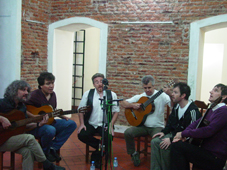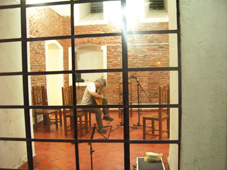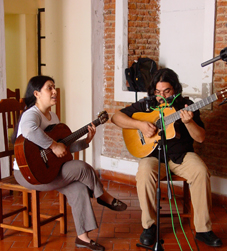La Peña – The South American Social ClubThe emergence of the nueva canción is inseparable from that of the so-called peñas. In the middle of the last century the movement begins in Argentina, Chile and Uruguay. This is the time of the Argentinean military dictatorship, and radio stations are forced to play regime-friendly music. In reaction, a rediscovery of traditional Argentinean music occurs. The Argentinean singer Atahualpa Yupanqui becomes a popular figure known for composing a new type of music and for his exceptional interpretations. He travels his homeland and researches the musical folklore of rural Argentina. Folk music performed with his outstanding guitar technique and self composed songs tells the story of the common man. In Chile and Uruguay, the same ideas spread. The Chilean artist Violeta Parra studies the folklore of her hometown Chillán, and later of all of Chile. Her studies, travels and performances of Chilean folk music help folklore gain great popularity. She founds a cultural center in La Reina and later the Peña de Los Parras, an important place for the nueva canción movement. Peñas become important venues with a social network. Music, dance, eating and conversation take place there. Many of the musicians begin studying the traditional style of their hometowns and the surrounding rural areas. Ironically, the violent suppression of nueva canción through Pinochet’s military government in Chile set an underground movement in motion that spread this music with the desire for freedom throughout all of Latin America. As far as Mexico, canto nuevo is listened to and produced. Numerous peñas open their doors to folk musicians in Mexico City and present young composers. In Cuba nueva trova is born with the singers Silvio Rodríguez and Pablo Milanés. South American musicians like the world famous singer Mercedes Sosa and the prominent singer, poet and journalist Alfredo Zitarrosa sing of the injustices suffered under repressive dictatorships, of heroes, human rights and the equality aspired to. Farther north in Venezuela, Alí Primera writes rebellious and political songs, denouncing poverty and the abuse of the oil companies. In Nicaragua, Carlos Godoy and his brother Luis Mejía Godoy become the voice of impoverished farmers and workers. Almost everywhere in South America people meet in the peñas, music bars, in order to sing, talk, drink, dance and eat. The roots of peña music can be found in the traditional folklore of rural Latin America in combination with lyrics that tell stories from almost normal daily life. The songs are a tribute to the people, their tradition and homeland. Meanwhile, the political situation in South America has changed. The dictatorships are no longer in power, the social conditions seem to be improving. The fear of repressive regimes is no longer acute. Critical protest songs have given way to stories about love, yearning, society and the problems which remain. The peñas are still places of social bonding, where the common people come together. The album »La Peña – The South American Social Club« presents Argentinean folklore of today, played by the vocal and instrumental group Santaires, the Duo El Filón and guitarist Roberto Calvo. It was recorded with simple equipment in the patio of Museo Penitenciario, a former women’s prison, in the urban district San Telmo in Buenos Aires.
Santaires: 1983 the brothers Cesar and Tato Angeleri and Roberto Calvo meet to form a trio in order to play, arrange and compose together folklore guitar music. Influenced by musicians such as Los Andariegos, Los Huenca Huá a. o. they decide to build a quartet and accept the young guitarist Héctor Barría as an additional member. The ensemble receives its first winner's award at the Pre Cosquín competition in 1986. After the sudden death of Héctor Barría, Roberto Calvo becomes responsible for the musical direction of Santaires, who establishes greatly in the musical world after several reshuffles as an acknowledged vocal and instrumental sextet. Roberto Calvo remains until today the musical leader. The ensemble provides a rich repertoire of folklore, folkmusic from all of Argentina's provinces, theatre music ("La Calma"), Yupanqui interpretations and own compositions based on traditional rhythms and forms and has gained a significant place in Argentina's music scene. Diego Escudero (vocals): born in Avellaneda in the Province of Buenos Aires, studied piano and singing and became an active member in several choirs from 1987 until 2000. With Coro de Cámara Adrogué he has achieved the first prize in the category "mixed choir" at Franz Schubert Competition in Vienna, 1996, and took part in the first Choir Olympics in Linz, Austria, in the year 2000. Juan Concilio (vocals and guitarrón): born in Pergamino in the Province of Buenos Aires, piano studies with Pedro A. Manzoni, counterpoint and composition with María del Carmen Aguilar. In 1999 he received a scholarship from the Fondo Nacional de las Artes in order to extend his studies on the interpretation of folklore music and starts afterwards an intensive work as the leader of different choirs: Ostinato, Choir of the Technical University in Avellaneda, musical director of the Choir Asociación Bancaria in Buenos Aires and vocal group La Propaladora.
Tato Angeleri (vocals, guitar): born in Buenos Aires, coming from a family of musicians he started to study singing and playing the guitar at an early age with his father Mario Angeleri, Alberto Sará and Roberto Calvo. Tato Angeleri sang in several folkloristic groups, Santaires being the most important among these projects. With the guitar orchestra El Guitarrazo he performed worldwide at guitar festivals. The founding member of Santaires is furthermore very active and specialised in teaching the guitar to children.
Javier Pérez (vocals, guitar): born in Gualeguaychú in the Province of Entre Ríos, studied guitar and singing at the Conservatory Carlos López Buchardo and electronic organ (Yamaha Academy). Founder of the instrumental-vocal group Vinca, specialised in the musical tradition of Entre Ríos. Besides his active musician career he also works as a guitar teacher.
Horacio Felamini (vocals): born 1969 in Buenos Aires, he sang in choirs from early childhood on and founded in 1981 his first own vocal group. Later he additionally focused on percussion studies. With the male voice quartet Setiembre he was finalist at the Cosquín and Baradero Festivals. Besides Santaires he is a member of the ensembles Los Trovadores, Coro Ostinato and Romanticantes.
Roberto Calvo (vocals, guitar, musical director): born 1962 in Buenos Aires, studied guitar and composition. 1988 he wins the first prize of the III Concurso Internacional de Guitarra in San Martín. Besides his activities as arranger, musical director and instrumentalist he can be heard on several recordings, among them "Adriana Nano y los bandoneones de Buenos Aires", which was nominated for a Grammy as best tango album in 2003. He teaches tango and folklore music at the Manuel de Falla Conservatory in Buenos Aires and at the Music School of Avellaneda. Since 2002 he is also the musical director of the guitar orchestra El Guitarrazo with around 40 members. Roberto Calvo has been awarded with several prices for his work in the folkloristic music world of his country: First prize of the Certamen Nacional de la Canción 1993, special reference at the Premio Nacional de Música de Proyección Folklórica y Popular (1990-1994) and winner of the Primer Certamen de la Canción Folklórica de Deán Funes (1999).
The Duo El Filón was founded in 2003 in Cordóba and soon found its way to important theatres to present their tango music. Zulma Ontivero, vocals and guitar, and Carlos Filipo, guitar, who graduated both from Félix T. Garzon Conservatory, have found their musical home in performing tangos, waltzes and milongas, most of the compositions and lyrics being written by the Duo. Their works to keep the rich tango tradition alive are recognized through important awards, for example at the singer competition "Anda a cantarle a Gardel" or at the competition "Obras de Tango, Vals y Milonga". In Buenos Aires they performed at well known tango venues such as the Casona del Teatro, the Casa del Tango, at the Museo Cultural del Tango or at the prestigious Festival Tango Buenos Aires. |
© Winter&Winter | Impressum | Datenschutz | Press Login | Back |


